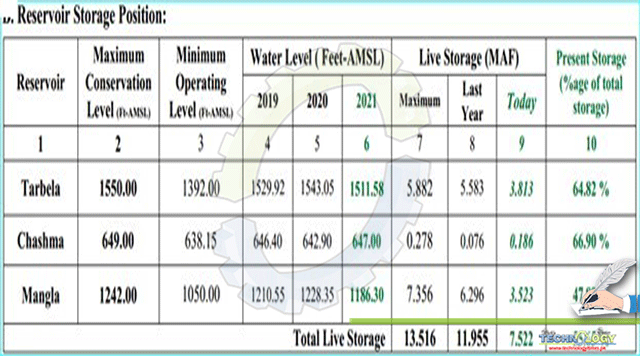Climate variation over the last few decades is an issue of great debate. The imaginable adverse effect of climate change, because of global warming, worries the scientists and other social communities, as it could have high impact on social and natural systems both at small as well as large scale.

By Engr. Salah Ud Din Deputy Director PCRWR
Pakistan is also vulnerable to climate change. Great variations have been observed in in recent years. Rainy days are decreasing, intensity of rain increasing which causing flooding and less availability of water at various period of the year.
Monsoon season of this year has been ended. During current year enormous shortages have been observed in the reservoirs. For example, Tarbela and Mangla reservoirs are 39 ft and 56 ft below from normal conservation level with 34% and 51% shortages in storage. overall, about 46% shortages have been observed in the three reservoirs namely Tarbela, Chasma and Mangla. Pakistan total storage capacity was for 30 days after construction of dams which is reduced due to sedimentation. Now even current storage capacities are not attaining its full capacities depite the fact that the national total rainfall for the year 2020 was 38% above average with 2020 being the 4 th wettest year since 1961. It is pertinent to mention that Since 2012 Tarbela and Mangla reservoir did not filled to its normal conservation levels. We have less water to maintain eco system and to avoid sea water intrusion. Sea water intrusion is a serious issue due to which thousands of acre land wasted in the lower indus plan. During 2019-20, 14.16Million AF water has been escaped from kotri with 10.86million AF (77%) in the month of September. During 2020- 21, the situation is even worst, only 2.143 MAF water has been flowed below kotri with 70% in the month of august and 5% in the month of September.
According to Pakistan meteorological department, during this monsoon season (2021), 24% less rainfall has been observed through the country. Monsoon rain was started from 5 July with considerably more rain than normal in KPK and Punjab but Sindh received 47% less than normal during the month of July. During august throughout the country 55% less rainfall occurs from normal which is third driest month on record. Many stations in Sindh and Punjab did not received even a single drop of rain in the month of august. Punjab and Azad Jammu Kashmir were 2nd driest months on record with 57.7% and 60.5% less rainfall. The month of August was ranked 10th dry in term of less rainfall in KPK (-34.3%) and Sindh (-89.2%). The situation was not different over Balochistan (-48.6%) and Gilgit baltistan (-12.8%).
If I talked about temperature the maximum temperature is increasing and minimum is decreasing. 2020 Pakistan’s annual national mean temperature was 0.22 °C above normal, the 9th warm year in decade. During the month of august 2021 the national mean monthly temperature was 0.21 °C
warmer than average. The mean maximum temperature at country-level was 0.53 °C warmer than average. The mean minimum temperature was 24.22 °C, being 0.10 °C lower than average. In light of above climatic variability, serious efforts need to be taken to cope with challenges otherwise we have no option to survive.

